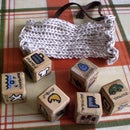Introduction: Jurassic Gingerbread
This is a recipe for a tasty, crunchy-chewy gingerbread, presented as a huge party-sized slab for breaking and sharing - design inspired by fossils from the Jurassic coasts of Great Britain.
Step 1: The Recipe
- 250g of plain white flour (all-purpose flour) - that's approximately 2 cups
- 50g salted butter (about 2 ounces, or a cube about an inch and a quarter each way)
- 100g light brown soft sugar (about 4 ounces or 3/4 cup) - you can substitute white sugar or a mixture of white and dark brown, etc
- 4 tablespoons golden syrup - you can substitute corn syrup, or molasses (gingerbread will be dark and rich) or honey
- 1 heaped teaspoon ground ginger root
- 1 heaped teaspoon ground cinnamon
- milk or water - small amount for mixing
- Sift the flour and spices into a large bowl
- Put the sugar, syrup and butter into a small pan and gently heat it, stirring all the time until the butter is melted and the sugar dissolves into the liquid - it should be a smooth, runny mixture - not too grainy
- Pour the sugar mix on top of the dry ingredients
- Mix together with a table knife - it should eventually come together into a crumbly dough
- Add just a little milk or water (a teaspoon or so at a time) and mix again - repeat until the crumbs stick together into a pliable dough
Step 2: Roll Out the Dough
Divide and set aside about one third of the dough
Roll the remaining two-thirds out on a lightly-floured surface, until it's about 4mm thick - it should be big enough to just fit on a 30cm (12 inch) cookie sheet
Transfer the dough to the cookie sheet (you can do this by rolling it gently around the rolling pin, then unrolling it in place. If your cookie sheet is not very reliably nonstick, cover it first with a sheet of reusable nonstick baking film or lightly oiled greaseproof paper
Use a chopstick or other straight edge to give the surface a rock-like texture
Press a bottle cap or other small circular object into the surface here and there to mark out some shallow depressions
Step 3: Make the Fossil Shells
Set the rolled-out dough aside and retrieve the portion you reserved earlier.
Test that it's pliable enough to work by hand - roll a small ball between your palms - if it flakes or crumbles, soften the dough by working in a little more milk or water - just cut and mix it into the dough with a knife.
Take small pieces of dough and roll them into long, tapered cones.
Mark a series of evenly-spaced lines all the way along - either with the blunt side of a knife, or by rolling a small balloon whisk gently along.
Starting at the thin end, carefully coil up the dough into a spiral, then slice off the thick end square to make the shape of an Ammonite shell
Carefully transfer the shells to their places on the rolled-out slab - make an assortment of different sized shells (the larger ones fit into the circular depressions made earlier - the small ones can go straight on top) Roll some of them up the oposite way, for variety.
Step 4: Imprint the Dough
For just a little extra authenticity you can use a (cleaned, washed) fossil to make impressions in the dough. (This is a pyritised Ammonite I collected at Charmouth in Dorset)
If you can't find a suitable fossil for this, you might be able to find a rubber stamp in a craft store, or make a model out of air-drying clay to use.
Step 5: Bake
Preheat your oven to 150C (300F or Gas Mark 2)
While the oven is heating, chill the unbaked dough in the fridge
Bake for 6 minutes, then turn the tray around and bake for a further 6 minutes, or until the edges of the dough are turning golden brown
Step 6: Cool
When the gingerbread is cooked, remove from the oven and allow it to cool on the tray for 10 minutes - it will be too soft and fragile to handle when hot.
Separate the gingerbread from the tray or baking sheet with a thin blade such as a palette knife, then slide it carefully onto a wire rack to cool - it also helps if you incline the wire rack a little - this allows the steam to escape from underneath - and prevents the middle of the piece turning soggy.
When completely cool, the edges of the slab will be crunchy and the middle and thicker parts will be slightly chewy - something for everyone.

Participated in the
Cookie Contest













